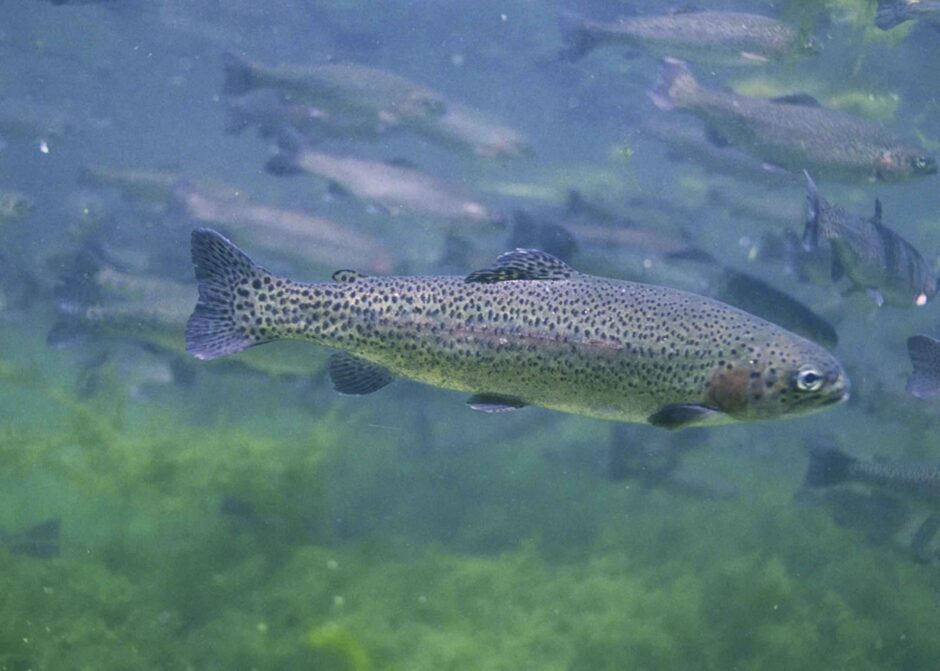Split Opinions: Aquaculture in Lake Huron
 Rainbow Trout. (Credit: Engbretson Eric / USFWS via Pixnio Public Domain)
Rainbow Trout. (Credit: Engbretson Eric / USFWS via Pixnio Public Domain)Lake Huron’s waters are split between Canada and the United States, and the two countries have contrasting approaches to fish farming on the lake. According to Info Superior, Canada has had net pen aquaculture since 1982 and twelve sites currently operate in Lake Huron, four of which are Indigenous-owned.
These fish farms allow managers to rear a host of fish that have a significant impact on the regional economy in terms of jobs and exporting seafood. Seeing the success of aquaculture on the Canadian side has encouraged conversations on the other side of the lake. While fish farming in Canada is legal, the U.S. has historically been split on aquaculture in the Great Lakes.
U.S. and Canada Clash over Fish Farming
In 2016, a Canadian company, Cold Water Fisheries, was looking to expand its fish farming business from the Canadian side of the lake to near the Michigan shore. The expansion would bring millions of pounds of rainbow trout, also known as steelhead, to a proposed site near Escanaba Bay, Michigan.
Conditions in the bay are similar to those in Fraser Bay, an inlet of Ontario where the aquaculture company has a successful installation that has operated for more than 30 years. But despite that track record, regulators in the state of Michigan have concerns about the facility.
The hesitancy emerges from several concerns discussed in a 2015 report submitted to the Michigan Quality of Life group. One of the major concerns surrounding introducing fish farming to the Great Lakes is that a large-scale aquaculture operation would bring millions of rainbow trout growing up in one spot, all the while excreting waste that is rich in phosphorus.
Phosphorus loading is linked to increased harmful algal blooms, a hazard that has plagued many of the Great Lakes in recent years. While managers with the fish farming company say that they haven’t seen many impacts in their past operations, Michigan is still hesitant to green-light the project due to public opinion.
Local officials and citizens who have been plagued by contaminated drinking water and other environmental issues that are connected to health conditions are particularly nervous about the project. Cold Water Fisheries has tried to quell concerns surrounding phosphorous, noting that it can be absorbed by fish like perch and suckers as well as by smaller invertebrates.
Even if there were increases in phosphorous concentrations, some scientists believe the change could benefit Lake Huron. In contrast to Lake Erie, which has very high concentrations, Lake Superior has exceptionally low quantities of phosphorous. Some scientists believe that this low-phosphorus problem could be linked with “rock snot” algae in some of that lake’s tributaries.
One of the other reasons voiced by dissenters was the prospect of the spread of disease from the farmed fish. In particular, an escapee could spread disease to one of the rainbow trout stocked by the state every year. However, this is a risk even associated with the stocked fish who also may be carrying disease.
Conclusion
While there are several concerns surrounding the initiation of fish farming in Lake Huron, introducing the practice to the region also has the potential to improve the region. One of the most obvious is that the move would contribute a lot of money and jobs to the region. As indicated in another report, this one led by Michigan State University, the expected production value of the trout could be about $5.5 million annually.
However, these benefits would not be immediate, and it appears that there is still a great deal of research that needs to be conducted before the U.S. will legalize the practice. Michigan state regulators recommend starting out with some small fish farms in Lake Huron to see how they do. Small operations, they argue, aren’t likely to have big impacts on the surrounding ecosystems while the practice is assessed.
They also emphasize that fish farming can be beneficial to the public and harmless to the surrounding system when the industry is well-regulated and well-monitored. The topic of aquaculture in the Great Lakes resurfaces in popularity every several years, and groups are still investigating the possibility of a program on the U.S. side of the lakes, so it is possible that the industry may expand in the future.



0 comments